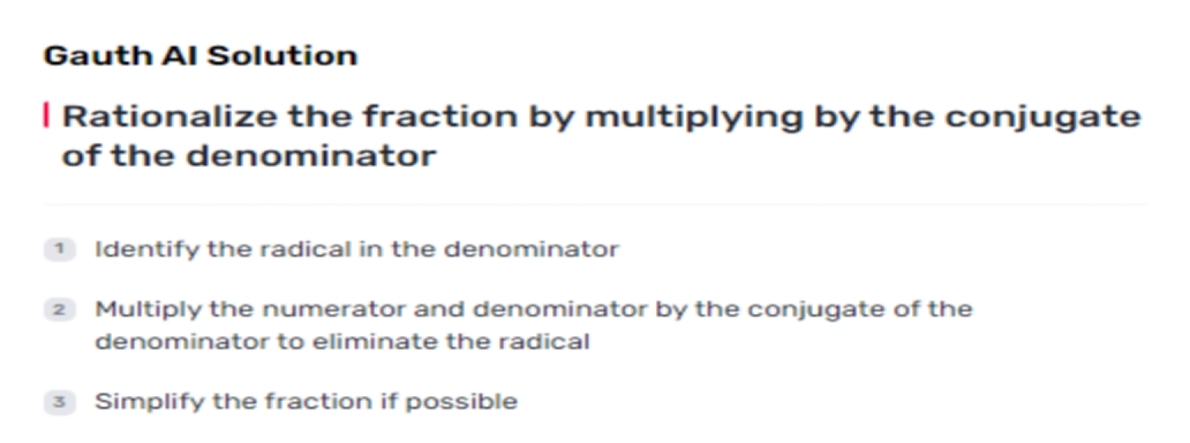The rationalization process aims to rewrite the fraction so that it does not contain any irrational components in the denominator, such as square roots or cube roots. By supporting a small portion, mathematicians can improve on estimations, control logarithmic articulations all the more really, and frequently reveal connections that may be clouded by complex denominators.
Rationalizing fractions can be accomplished in a variety of ways. Every strategy has its materialness relying upon the particular type of portion, and understanding these procedures furnishes mathematicians with flexible instruments to deal with different arithmetical difficulties. Justification in Rationalize a Fraction problem improves computational effectiveness as well as extends appreciation of numerical connections and designs.
Different Methods for Rationalizing
The process of changing the form of an algebraic expression, typically a fraction, to remove radicals or other complex terms from the denominator is known as rationalization in mathematics. This method is especially helpful for making algebraic expressions easier to understand and simplifying calculations.
Multiplying by the Conjugate
This technique is mostly used for fractions with square roots. To excuse the denominator, you increase both the numerator and the denominator of the division by the form of the denominator. The form is framed by changing the sign between the conditions of the denominator. For instance, assuming that the denominator is \( \sqrt{a} + b \), its form would be \( \sqrt{a} - b \).
Using the Difference of Squares
When defied with divisions where the denominator is a binomial squared (e.g., \( a^2 - b^2 \)), the distinction of squares technique is compelling. This procedure includes considering the denominator into its constituent terms (e.g., \( (a - b)(a + b) \)) and afterwards reworking the part as needed. Thus, the squared term in the denominator is killed, changing the portion into a judicious structure without revolutionaries.
Using the Sum or Difference of Cubes
The sum or difference of cubes method is used for more complex fractions with cube roots or higher powers. This strategy requires perceiving designs in mathematical characters, for example, \( a^3 + b^3 \) and \( a^3 - b^3 \), which can be calculated into sensible structures. By applying these characters, the portion can be reworked such that eliminates the shape roots or higher powers from the denominator.
Using Gauth To Rationalize a Fraction
Gauth is one of the best-known platforms that can be used for different purposes like solving a problem including Rationalize a Fraction. The steps for these types of problems are given below.

Step 1: Enter Gauth
The first step in using Gauth to solve problems is to access the platform by going to the Gauth website or app. This normally includes signing into a record or getting to the stage's connection point where you can associate with its elements.
Step 2: Type Question
When inside Gauth, clients can continue to type their inquiry or issue into the given search or information field. Also, the User can select the problem from the gallery or input the link to the given question. This step includes plainly figuring out the question such that Gauth's calculations can be comprehended and processed successfully.
Step 3: Find Free Trial
Users can choose to find or activate a free trial, if one is available, prior to receiving the solution. This step includes exploring through the stage's choices to find and initiate any times for testing or special offers that permit admittance to arrangements without prompt installment.
Step 4: Get Solution
In the wake of entering the inquiry and, if material, enacting a free preliminary, clients can continue to get the answer to their concerns. Gauth regularly gives definite clarifications, bit-by-bit arrangements, or explicit replies, contingent upon the idea of the question entered. Clients can then survey and use the arrangement given to address their intellectual or critical thinking needs successfully.
Final Wording
Understanding the different techniques for defending a division prepares mathematicians and understudies the same with flexible devices to really control and improve on logarithmic articulations. Each technique transforms fractions into rational forms devoid of radicals or complex terms in the denominator by eliminating square roots using the difference of squares for binomial denominators or using the sum or difference of cubes for higher powers.


